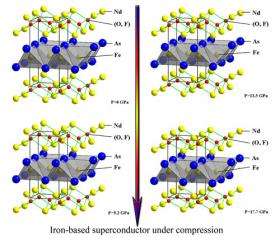Putting the Pressure on Iron-Based Superconductors

(PhysOrg.com) -- Traditionally, magnetism and superconductivity don't mix. For more than 20 years, the only known superconductors that worked at so-called "high" temperatures (above 30 K, or about -406 degrees Fahrenheit) were almost all based on copper. Materials with strong magnetism, scientists thought, would disrupt the pairing of electrons that is key to achieving the frictionless flow of superconductivity. So when a group of researchers recently found high-temperature superconductivity present in a class of iron-based materials, their discovery shocked and excited the scientific community.
"Many people didn't believe that iron could be an effective superconductor. It went against all prior knowledge," said Haozhe Liu, a professor at the Harbin Institute of Technology, in China. "Now, we've entered the iron age of superconductivity."
Made from conducting layers of iron, arsenic, and various other elements, this new class of materials could lead to applications such as more-efficient power transmission. However, iron-based superconductors are still in the early stages of experimentation and implementation. That why Liu and colleagues from the Chinese Academy of Sciences and the NSLS set out to study the characteristics of a specific iron-and-arsenic-based, neodymium-containing superconductor.
"There is very little information out there right now about this type of superconductor and we want to find out as much as we can about its structure, its behavior, and how it changes under varying conditions," Liu said.
The main objective for scientists in the field is to find superconductors with the highest transition temperature (Tc). Cuprates, also called high-temperature superconductors, hold the record thus far, with transition temperatures reaching up to 138 K (-211 degrees Fahrenheit) - still a far cry from room temperature and impractical for everyday use. In early investigations, the iron-based superconductors studied so far have been shown to have a maximum Tc of 50 K (-370 degrees Fahrenheit).
To find out how Tc is affected by high pressure in the iron-based neodymium arsenide superconductor system, the research team subjected their samples to more than 30 GPa with NSLS beamline X17B3's diamond-anvil cell, a device that uses the polished faces of two diamonds to apply extreme pressure. High pressure can compress the crystalline structure of the material and force its layers closer together, which might increase the material's Tc by improving charge transfer between the layers. To measure this effect, the researchers used angle-dispersive x-ray diffraction. But their findings didn't turn out exactly as expected.
The team's results, which are reported in the October 22, 2008, edition of the Journal of the American Chemical Society, show that as pressure increases from 0 to 15 GPa, the spacing decreases and Tc increases marginally. But as the pressure increases further, one of the other lattice parameters abruptly increases and the Tc drops.
"After a certain point, there is actually a negative relationship between pressure and Tc," Liu said. "This is a new concept and something that could offer insight on how to design and create other superconducting systems."
More information: J. Zhao, L. Wang, D. Dong, Z. Liu, H. Liu, G. Chen, D. Wu, J. Luo, N. Wang, Y. Yu, C. Jin, and Q. Guo, "Structure Stability and Compressibility of Iron-Based Superconductor Nd(O0.88F0.12)FeAs Under High Pressure," JACS, 130 (42), 13828-13829 (2008).
Provided by Brookhaven National Laboratory





















